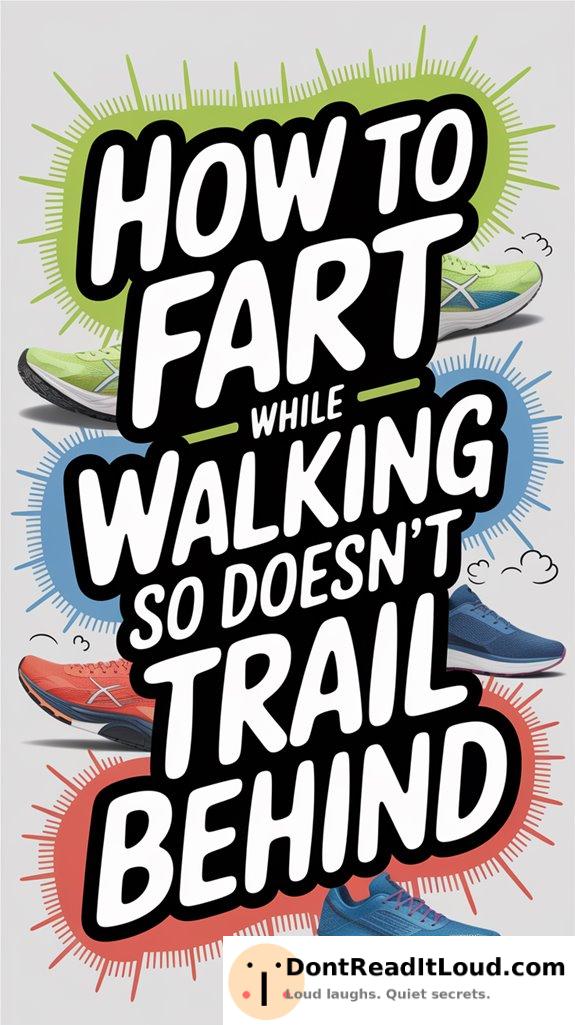
To fart while walking without leaving a trail, maintain a steady pace and sync your release with a heavy step or background noise. Wearing loose, thick clothing can help conceal any sounds and diffuse odor. Walk naturally to avoid drawing attention. Take advantage of breezes or nearby bushes to help carry the smell away. For even greater discretion and confidence, there are subtle tricks you can try.
Understanding Why Fart Trails Happen

When you fart while walking, your movement pushes air backward, creating what’s known as a “fart trail.”
As you move, your legs and clothing help direct the gas behind you, increasing the chance that others will encounter the lingering smell. This occurs because of the way gas disperses and how your body moves.
Each step produces air currents that push the gas out of your clothing and into your wake. Tight clothes may briefly trap the gas, but movement eventually releases it.
The swing of your legs and the friction from fabric help guide the scent along your path. Knowing how body mechanics affect gas dispersion explains why fart trails often follow you while walking.
Choosing the Right Walking Pace

Understanding how gas moves when you walk helps you handle the aftermath more discreetly.
Walking too slowly lets the odor linger and makes it easy to trace. If you move too fast, you might stir the air and drag the smell along with you. Aim for a moderate, steady pace to help the odor disperse naturally.
Walk smoothly and keep your steps even—avoid stopping suddenly or changing directions without warning. By managing your speed and moving with purpose, you make it harder for anyone to guess where the smell came from.
Timing Your Release Strategically

Although it might feel awkward, choosing the right moment to let go makes a big difference.
Mastering timing helps your release blend naturally into your stride. Watch for subtle cues from your body, like a shift or twinge, to know when it’s almost time. If you’re walking at a steady pace, try releasing during a heavier step or a slight speed-up. This can help mask any sound and spread the gas more discreetly.
Don’t rush—wait for a lull in conversation or a burst of background noise to cover it. By paying attention to these signals and adjusting your timing, you’ll lower the chance of your fart lingering behind you.
Using Your Surroundings to Your Advantage

Being aware of your surroundings helps you find clever ways to cover up your release.
Scan for background noise, like passing cars or construction, to mask any sounds.
Don’t forget to use airflow—stand where the breeze can carry away odors quickly.
Look for bushes, benches, or other obstacles to shield yourself from view.
Move naturally and blend in so your actions go unnoticed.
Perfecting Discreet Body Positioning

When you want to let one slip without drawing attention, your body position makes a big difference. Mastering body mechanics helps you control sound and direction, making your release less obvious.
As you walk, keep your movements easy and relaxed—avoiding stiffness, which can seem unnatural. Subtle posture changes can help, too. Lean forward a little or shift your weight gently; this can redirect the gas and help it disperse.
Don’t clench or move rigidly, as tension can make things noisier. Instead, stay comfortably upright and at ease. If needed, slow down slightly to better control the moment.
With practice, good posture and smooth movement will make your efforts blend in seamlessly.
Dressing Smart to Minimize Detection

Along with moving smoothly and maintaining a relaxed posture, your clothing choice is key for staying discreet. Choose thicker fabrics like denim or heavy cotton to help muffle sound and draw less attention.
Steer clear of tight or synthetic materials, as they can be noisy and may retain odors. Looser pants or skirts allow air to circulate, helping to disperse smells rather than trap them.
Some people use scent blockers, such as odor-neutralizing underwear or charcoal pads, for extra reassurance. These products help absorb and minimize noticeable odors before they become an issue.
Quick Recovery Techniques if You Get Caught

Despite your best efforts, you might still find yourself exposed after an unexpected noise or odor. In these moments, your best move is a quick exit. Casually pick up your pace, as if you’re suddenly in a rush. If someone seems suspicious, stay calm and carry on as usual.
If leaving isn’t an option, handle the situation with grace. Among friends, a brief, light-hearted apology can ease any tension. Humor is often the best remedy for embarrassment.
In public, simply avoid eye contact and wait for the moment to pass. Avoid blaming others or causing a scene, as this only draws more attention. Remember, everyone has awkward moments. Staying composed and tactful helps you move on with minimal embarrassment.
Conclusion
Now you know how to fart while walking without leaving a trail. It’s all about timing, speed, and making the most of your surroundings. With a bit of strategy—like walking faster, using cover, or wearing the right clothes—you can stay discreet. If something goes wrong, just recover calmly and keep moving. Walk with confidence and leave no evidence behind!



